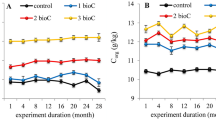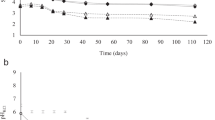Abstract
SPECTROSCOPIC investigations of soil humic acids in the visible region have hitherto been of little value in indicating the nature of these compounds. Humic acids usually show an almost featureless absorption curve in which optical density increases with decreasing wavelength over the visible scale. Work on Japanese humic acids1,2, however, has disclosed the widespread distribution of a form described as “P type”, which is commonly present in podzolic soils and alpine grassland soils, and may also be detected in forest brown earths and yellow earth soils. P type humic acid has absorption bands near 620, 570 and 450 mµ, which are of variable intensity in humic acids from different horizons and from different soil types. This absorption occurs because there is a green pigment which can be separated from the remaining dark brown humic complexes by chromatography on columns of cellulose powder2. The purified green pigment from Japanese humic acids has λmax near 615, 570, 450 and 430 mµ in aqueous alkali. Green humic acid is easily soluble in alkali, concentrated sulphuric acid and pyridine, moderately soluble in methanol, ethanol and nitrobenzene, and weakly soluble in chloroform, ether and tetrachloroethane. Work in Japan (personal communication) suggests a possible relationship to a perylene quinone. It may be related to a pigment previously isolated from irregular olive green patches in Australian lateritic and podzolic soils. This pigment was considered to be a hexachloro-polynuclear quinone of the dihydroxyperylenequinone or dihydroxydinaphthylquinone type3.
This is a preview of subscription content, access via your institution
Access options
Subscribe to this journal
Receive 51 print issues and online access
$199.00 per year
only $3.90 per issue
Buy this article
- Purchase on Springer Link
- Instant access to full article PDF
Prices may be subject to local taxes which are calculated during checkout
Similar content being viewed by others
References
Kumada, K., and Sato, O., J. Soc. Soil and Manure, Japan, 36, 373 (1965).
Kumada, K., and Sato, O., Soil and Plant Nutrit., 8, 31, (1962).
Butler, J. H. A., Downing, D. T., and Swaby, R. J., Austral. J. Chem., 17, 817 (1964).
Hurst, H. M., and Burges, A., in Soil Biochemistry (edit. by McLaren, A. D., and Peterson, G. H.) (Marcel Dekker, Inc., New York, in the press).
Burges, N. A., Hurst, H. M., and Walkden, B., Geochim. Cosmochim. Acta, 28, 1547 (1964).
Morrison, R. I., J. Soil Sci., 14, 202 (1963).
Ferdinandsen, C., and Winge, O., Kgl. Veterinaer og Landbohojsk., Aarsskr., 332 (1925).
Trappe, J. M., Lloydia, 27, 100 (1964).
Kononova, M. M., in Soil Organic Matter (Pergamon Press, London, 1961).
Scheffer, F., and Ulrich, B., in Humus und Humusdüngung (Ferdinand Enke Verlag, Stuttgart, 1960).
Author information
Authors and Affiliations
Rights and permissions
About this article
Cite this article
KUMADA, K., HURST, H. Green Humic Acid and its Possible Origin as a Fungal Metabolite. Nature 214, 631–633 (1967). https://doi.org/10.1038/214631a0
Issue Date:
DOI: https://doi.org/10.1038/214631a0
This article is cited by
-
Soil carbon storage predicted from the diversity of pyrolytic alkanes
Biology and Fertility of Soils (2018)
-
Biogenic polycyclic aromatic hydrocarbons in sediments of the San Joaquin River in California (USA), and current paradigms on their formation
Environmental Science and Pollution Research (2016)
-
Reactive matrix clean-up of naturally occurring perylene in young lignite
Analytical and Bioanalytical Chemistry (2008)
-
Land use and soil carbon accumulation patterns in South African savanna ecosystems
Biology and Fertility of Soils (2005)
Comments
By submitting a comment you agree to abide by our Terms and Community Guidelines. If you find something abusive or that does not comply with our terms or guidelines please flag it as inappropriate.



